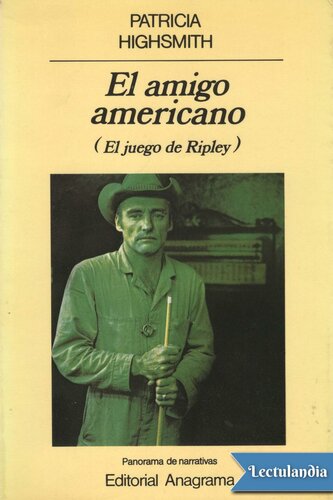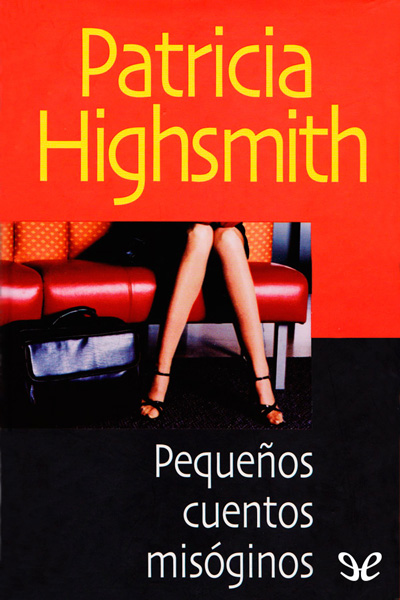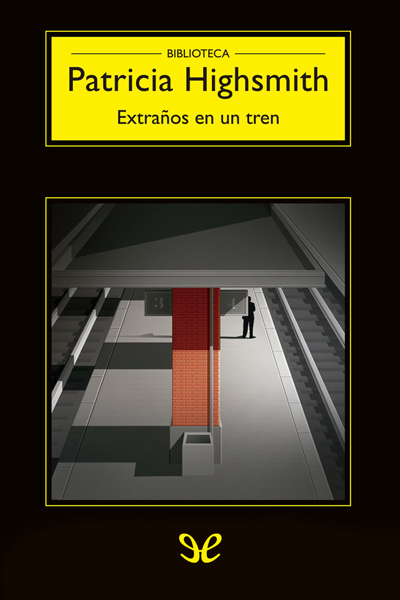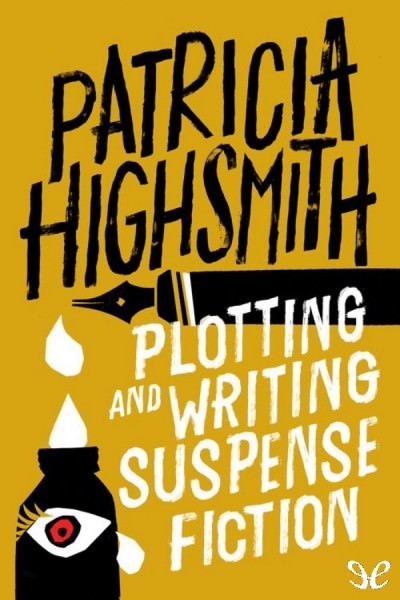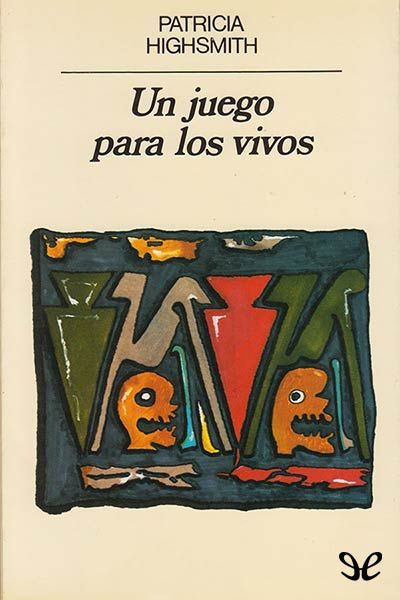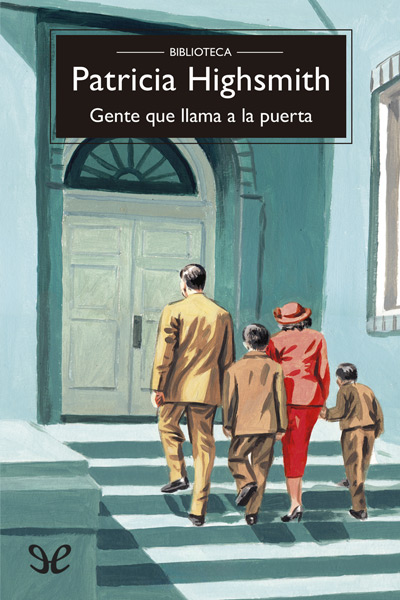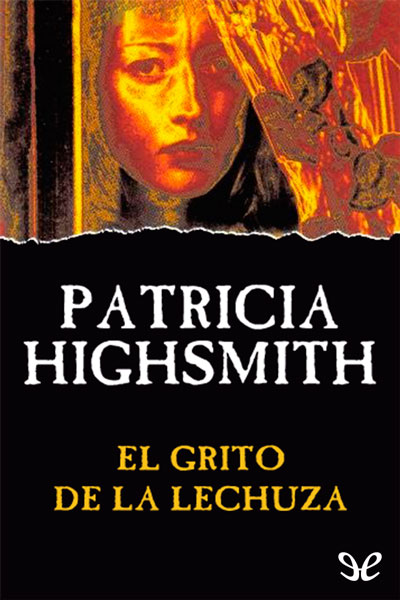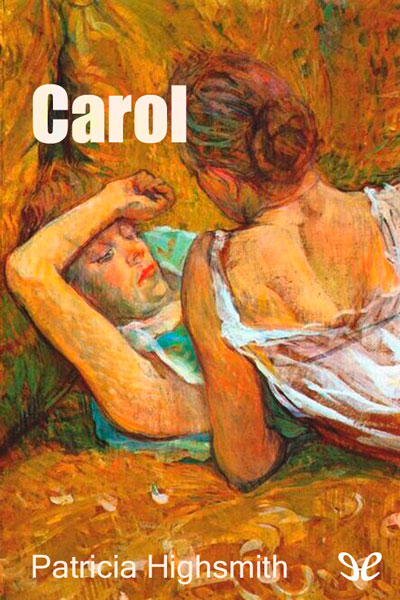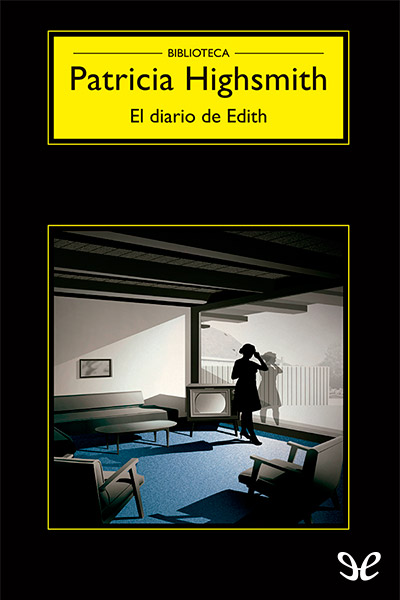oleebook.com
Petits contes misûýgins de Patricia Highsmith
de Patricia Highsmith - Gûˋnero: Humor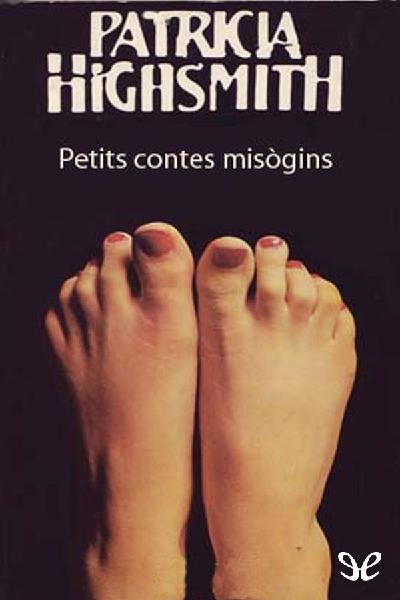
Sinopsis
Petits contes misûýgins (1975) ûˋs una antologia de contes de lôescriptora nord-americana Patricia Highsmith. Els contes recollits aquûÙ sû°n notables per la seva brevetat ôalguns tenen nomûˋs un parell de pû ginesô i pel seu to macabre i cû ustic, titllat per alguns dôexcessivament pessimista. El tema de fons de cada histûýria ûˋs lôabû¤s i/o la desgrû cia de les dones, dôaquûÙ el tûÙtol del llibre, perûý de retruc les histûýries amaguen tambûˋ una severa i despietada crûÙtica a la doble moral i al que sôha vingut a anomenar lôAmerican way of life.
Libros Recomendados - Relacionados
ReseûÝas Varias sobre este libro
I know. What a title, right? Without any intended snark whatsoever, I'd say the brilliance in this somewhat obscure short story collection is all in the title(s).
Really, it is. Because she says it in the title, she takes all the power away from an earnest reader who, clutching pearls, is compelled to say "oh, goodness, she's such a misogynist!" Come now, earnest reader, Pat is satirizing misogynist stereotypes, and you can tell she had a ball doing so.
Each very brief story features a woman that Patricia Highsmith wants you to hate (The Coquette, The Breeder, The Silent Mother-In-Law, The Invalid, The Prude -- to name a few) and, in broad, fable- form, the woman dies, or she destroys those who are unlucky enough to be in her sphere.
The satire is complicated. You really get a picture of the complex relationship Pat had with her own gender, here. Sometimes, it doesn't entirely succeed as satire for me, and simply presents as subversive naughtiness. That's okay with me; my issue is that the stories get so repetitive. The awful woman does her awful stuff, and then she or others die. As much as I can get on board with this reckless idea, it loses its sting, after a while.
The first story The Hand is by far the best and most memorable for me. It is wicked, it is wonderful, and it tells in very few words why asking for a woman's hand (in marriage) is not only barbaric, it's criminal.
But back to those titles. Just the table of contents is amazing and could make a brilliant prose poem. Did I mention The Fully-Licenced Whore, or The Wife? Or, perhaps, The Mobile Bed-Object? Only you, Pat.
3.25 stars (though I reserve the right to gain more appreciation for these nasty little numbers as time goes on)2021 american highsmith ...more68 s1 comment Emily B467 482
I was really excited by the title and the author so didnôt think twice about buying it. After reading, I have a feeling that I wonôt be able to recall much of this book at a later date51 s Mark Porton477 575
Little Tales of Misogyny by Patricia Highsmith is a lively collection of twenty or so short stories. Each story involves a female protagonist who is either the victim of, or perpetrator of a misdemeanour, situation or extreme act of violence. The stories are all so varied, and each of them interesting in their own right ô very short, only 4 or 5 pages on average.
But as Iôve come to expect with this author, she was full of surprises. Sometimes (often) I experienced a ôWTFô moment ô literally gobsmacked!!! Other times the story seemed to just peter out, others ended abruptly. There is a certain absurdity and satirical element to this collection. All worthwhile ô I must say!
My favourites were The Hand a great opening effort which was uber-macabre. Then The Dancer, oh so bloody sad!! Thereôs also The Perfect Little Lady about Thea ô this one had some unexpected full-blown violence and reminded me to beware of the ônice onesô. There are quite a few other crackers, thereôs also a small handful of stories which didnôt really have an impact on me, which I expected with a collection of short stories I suppose.
One of the most memorable moments was this wonderful, somehow comical description of the bombing of a School of Artsô ..yes, the bombing of an Arts School.
One piano went through the roof, a bit separated from the student who was still seated on the stool, fingering nothing. A dancer at last made a few complete revolutions without her feet touching the ground, because she was a quarter of a mile high, and her toes even pointing skyward. An art student was flung though a wall, his brush poised ready to make the master stroke as he floated horizontally towards oblivionô ô ..
Enjoyed this.
4 Stars
funny highsmith horror ...more42 s Roman Clodia2,615 3,547
Little Tales of Misanthropy
If you ever feel out of sorts with the world (yes, the whole world) then this would be an ideal read. In what feel cathartic vignettes which ditch any sense of PC-ness, Highsmith takes aim at people - for while her stories are titled after a female character role (The Coquette, The Victim, The Breeder, The Prude, The Perfectionist amongst others), men don't come off any better: being weak or bullies, or foolish or just plain mean.
In my favourite story called 'The Fully-Licensed Whore, or, The Wife' (which kind of tells you all you need to know of Highsmith's state of mind!) Sarah pulls off the perfect murder - but I'm not going to tell how.
So these are full of a black and nasty humour: little gems of malice and malevolence that had me sniggering throughout.39 s Richard1,019 439
3.5 Stars
If Aesop was abused by a mean, alcoholic mother and then jilted and heartbroken by the true love of his life, I think he would have written this book of short tales rather than his famous fables. This is a collection of tiny stories written by famed psychological noir writer and alleged cynic, woman-hater, and misanthrope, Patricia Highsmith. Each story focuses on a different vixen that everyone loves to hate: golddiggers, prudes, whores, perfectionists, mother-in-laws, and even an unlucky cave-woman. She was simple-minded and never lost her temper. She had been clubbed over the head so many times, her brain was addled. It was not necessary to club Oona to have her, but that was the custom, and Oona barely troubled to dodge to protect herself. And one of the best stories is the one about a man who is horrified to discover that his wife has transformed into an unstoppable baby-making machine! I got a kick out of this collection, really because of the style of writing: tongue-in-cheek and detached, while at the same time sad, sarcastic, and satirical, as if the tragic outcomes for these women were somehow inevitable and entirely justified. And I agree with Goodreader Andy Seven, it would be cool to see a companion collection about men everyone hates!author-highsmith cool-concept cool-titles ...more35 s Tamar...playing hooky for a few hours today635 185
LTOM is a collection of short, short stories by the queen of weird. There is certainly also a great deal of misandry thrown in, if only by virtue of the book's title. The first story was a little a twisted bible story or fable, the rest are mostly forgettable but definitely readable and weird.
One of the stories, The Victim, disturbed me more than the rest. In that story, the whole family could have benefited from psychiatric treatment (in my humble opinion). Is there a word misogyny/misandry for contempt of parents? Now that story is going to stick with me for a long time. I wonder if PH hated men, women, herself or everyone.
32 s Lotte583 1,123
3.5/5. These were all really fun, twisted little stories or in some cases, vignettes (a few stories are only three pages long). Reading this entire collection in pretty much one sitting did get quite repetitive however, since most stories ended the exact same way. Also, not all stories seemed to be about misogyny specifically, some were more about misanthropy in general in my opinion. If you're a fan of the dark humour and subtle terror of Roald Dahl's or Shirley Jackson's shorter fiction and your stories bite-sized, I'd definitely recommend this collection, just beware that most stories follow a very similar pattern.2018-read a-short-fiction c-20th-century ...more28 s Ana Cristina Lee713 304
Divertidos, crueles, demoledores y polûÙticamente incorrectos, asûÙ son estos 17 brevûÙsimos cuentos, cada uno de ellos titulado como un estereotipo femenino: La ûÝoûÝa, La perfeccionista, La vûÙctima, La paridora, La artista, La coqueta, La suegra silenciosa ô
Llenos de humor negro, despuûˋs de un retrato breve ô casi caricatura ô de los personajes, suele haber un final impactante, un crimen o un accidente que ponen fin a la trayectoria de la protagonista.
Patricia Highsmith nos deja pensando quûˋ quiso expresar con esta colecciû°n de visiones negativas sobre la condiciû°n femenina y sobre la sociedad en general. Por ejemplo sobre el matrimonio, en el cuento La prostituta autorizada o la esposa, equipara el matrimonio a una prostituciû°n legal:
Sarah siempre se habûÙa dedicado a eso en plan de aficionada, y a los veinte aûÝos se casû°, con lo que obtuvo la licencia.
La autora no justifica en lo mûÀs mûÙnimo la hipocresûÙa y la astucia de estas mujeres como estrategias de defensa ante la secular opresiû°n patriarcal, sino que a menudo presenta a los hombres como vûÙctimas:
Vamos, que el pobre Sylvester sû°lo valûÙa por su dinero ô no era rico pero tenûÙa una buena posiciû°n y porque era relativamente inteligente y presentable, no lo bastante agresivo para resultar una molestia yô Bueno, eso era mûÀs o menos lo û¤nico necesario para satisfacer a Sarah.
Creo que en esta obra ô a pesar de su tono de farsa ô podemos conocer un poco mûÀs a Highsmith: una mujer cuya gran inteligencia y, probablemente tambiûˋn, orientaciû°n sexual, la hacûÙan sentirse muy distante de las convenciones sociales de su ûˋpoca, con lo cual obviamente no encajaba en ninguno de los modelos femeninos al uso.
En resumen, que la Highsmith es mucha Highsmith.cuentos novela-negra26 s Deborah MarkusAuthorô 6 books663
I was saving this collection for a rainy day, and yesterday ô day 1 of a nasty, unexpected sinus infection ô was exactly when I needed to read this weird little book. (I still have said blitzkrieg infection, so please don't expect too much from this review.)
This book is very short, as are the individual stories contained therein. As for the misogyny of the title, it puts me in mind of Virginia Woolf's ponderings in A Room Of One's Own when she was asked to speak about women and fiction. Does that mean women and the fiction that's written about them, or the fiction that women read, or the fiction they write, or a combination of all of these, or something else altogether?
Similarly, even after reading this book, I have no idea if saying that these are little tales of misogyny means that the author hates women and has written stories to reflect that hatred, or if these are simply tales about misogyny. And if it's that last one, are these stories that celebrate misogyny, or that merely reflect it? Or could they be both?
And how is all of this complicated by the fact that the author in question is not only a woman herself, but one who was at least bisexual and possibly best described as a lesbian?
I probably wouldn't be able to figure all that out even if I were well. With my head stuffed up the way it is now, there's no chance.
All I know is I burned through this book and wish I were well enough to go to the library to get more of Highsmith's stories.
This is one of those pass/fail books. There's no room for neutrality here. You'll either eat these stories up potato chips, or you'll be left cold and possibly repulsed by them.
Or you might do all of the above. Because as I mentioned, this is a weird, weird little book.
i-have-weird-ideas-of-a-good-time own-a-copy23 s Toby846 364
Seventeen short stories, seventeen different women, the same offence everytime - being a woman.
Patricia Highsmith, the famed hater of women, or so they say. The Talented Ms Highsmith, the poet of apprehension (thank you Graham Greene,) and creator of countless literary psychological thrillers.
In her novels she takes time, slowly building the suspense and the tension page by page but some of these stories are only two pages long, instead she utilises her skill in observing and dissecting human behaviour with short, sharp bursts of insight.
From the story of a cave woman to the stories of the sexually liberated 70's step by step we meet "The Prude," "The Breeder," "The Victim," and "The Middle-Class Housewife." Satirical and dark sketches of obviously real people that are often caustically funny.
The caricatures of women in each incarnation carry the overall theme that a woman can never win, can never be in the right, that she is doomed to die horribly; even if she lives to old age she'll find that somewhere along the line her essence died yet allowed her body to continue.
On the surface you might consider that yes, infact Highsmith did hate women and these are nothing more than seventeen attacks on the behaviour of those she deemed worthless but it doesn't take much consideration to realise there's so much more to these stories.
It's sad, a criticism of men and society that when a female author discusses these crimes against women she is criticised for hating women.lit short-stories19 s Jenny (Reading Envy)3,876 3,507
I'd had this on my bookshelf for a few years and was looking for something light to read before bed. I finished it in a bubble bath, which seemed somehow appropriate. I'm not sure these are all that memorable, and I had that experience again of discomfort and admiration at Highsmith's writing all rolled into one. I can't decide if she's brilliant or frustrating, perhaps both.
Misogyny usually means the hatred or dis of women, but in this case, Patricia Highsmith is writing short little stories about women she wants you to hate. Or maybe they are typical of the types of women everyone loves to hate, from the perfectionist to the mother-in-law to the prude. Most of them die lonely deaths or live forgotten lives, some get the pleasure of both in only a few pages. Their brevity will translate to me not remembering them for long, which seems to only be what the author wants of me. Okay Highsmith, you win.read2014 short-stories10 s Kyra Leseberg (Roots & Reads)1,042
3.5 stars rounded up
Ugh, women---so complicated and much more trouble than they're worth.
That's why the underrated author Patricia Highsmith gave us this collection of short stories (2-8 pages average) about females doing things daring to work outside the home instead of take care of their family and young ones wearing too much makeup (of course they're asking for it!) *gasp* We should all be appalled by these vixens. ;-)
A great tongue-in-cheek collection that will make more than a few readers uncomfortable with its dark humor.
For more , visit www.rootsandreads.wordpress.com10 s Cemre708 518
Kad?n Dû¥?manl??? ûstû¥ne Kû¥ûÏû¥k ûykû¥ler, tamamen ismine kap?l?p ald???m bir kitapt? ve aûÏ?k sûÑylemek gerekirse beklentim kad?n dû¥?manl???n? aûÏ?kûÏa ele?tiren bir kitap okumakt?; ancak bu beklentimin tam manas?yla gerûÏekle?ti?ini sûÑylemek oldukûÏa zor. Bu tabiri do?ru kullan?yor mu bilmiyorum; fakat kitab?n bir "kara mizah" û¥rû¥nû¥ oldu?unu sûÑylemek gerek. Kitaptaki ûÑykû¥ler, tam manas?yla bir "kad?n dû¥?man?"n?n penceresinden yaz?lm??; ama ilk ba?ta siz de "bunlar ne i?renûÏ kad?nlar bûÑyle" diyorsunuz. Bir sû¥re geûÏtikten sonra Highsmith'in asl?nda baz? ?eyleri abartarak hikûÂyeleri anlatan zihniyetin nas?l "kûÑtû¥", "dû¥?manca" oldu?unu gûÑstermeye ûÏal??t???n? anl?yorsunuz, en az?ndan ben bu ?ekilde yorumlad?m diyebilirim. Kitaba dair okudu?um bir ele?tiri yaz?s?nda kitab?n kad?n dû¥?manlar?na ders veren bir kitap olmad???n?; fakat bir kad?n dû¥?man?na do?um gû¥nû¥nde hediye edilebilecek bir kitap oldu?unu okumu?tum. Bence kitap, tek cû¥mleyle ancak bu ?ekilde ûÑzetlenebilir.
ûykû¥lerin bû¥yû¥k k?sm? dûÑrt-be? sayfa, yani gerûÏekten "kû¥ûÏû¥k ûÑykû¥"ler; fakat bu size herhangi bir eksiklik hissetmiyor. Ben hem rahats?z olarak hem e?lenerek hem gerilerek hem merak ederek okudum. Bunda ûÏevirmen Nihal Ye?inobal?'n?n da pay? yû¥ksek. Orijinalini bilemem elbette; ancak kitab?n e?lenceli û¥slubunu ba?ar?yla yans?tt???n? dû¥?û¥nû¥yorum. 9 s Phillip405
this collection of tales gave me a whole new appreciation of patricia highsmith. i admit being puzzled upon selecting it after reading so many mixed GR . readers didn't seem to get what she's up to - why would PH write stories that trivialize women?
we understand that sociopaths don't see their victims as human beings, and because of this they are able to commit abuse without feeling remorse. in these stories it's important to see the shift in tone from highsmith's classic work, a signifier that she is writing satirical fables. most folk tales, these stories exist in order to teach us lessons on how to, or how not to act. in this short volume of fables, highsmith points out the ways that men abstract the female persona in the act of objectifying by creating chariacatures, rather than portraits of real life beings.
the stories in the first half of the book are short - most clock in at a page and a half and, all great sugar-coated medicine, they go down easy - i was laughing out loud while astonished by the madness represented. the ideas are refined and condensed and the plots so absurd it is clear that this isn't reality. as the book progresses, the stories get longer, the plots more involved, but the spell has been cast and highsmith's intent remains clear - these stories are classic satire on the follies commonly termed as the battle of the sexes.fiction humor short-stories9 s Gabriela Silva43 3
So what is this book about, and what is it for...? It does what it "says on the tin": these are very short tales of misogyny. But they're not satirical, they're not pointing out the misogyny around us, they're not addressing the unfairness of double standards, they're not suggesting that women have richer lives that what misogyny confines them to.
They're just misogynistic.
They're tales of women - often nameless and devoid of personality, just "women" - who accuse men of rape for their financial benefit, who have sex and are killed for is, or else don't have sex and are killed for it, or try to become better but are found ridiculous and mocked by the narrator.
So what's the point, really, or simply repeating the same hate and problems that we are surrounded by if we're not going to shine a critical or satirical light on them? Reading this book was slightly reading through online comments - and its enriched me just as much. I wouldn't recommend this to anyone. If you're interested in the author, she has got much better, more interesting, and equally misanthropic books.
One good story - "The Prude", because it allows for the existence of more than one type of women and actually has a sense of humour.
9 s Nigeyb1,306 323
Little Tales of Misogyny is a curious little collection of somewhat macabre short stories. Distilled esssence of Patricia Highsmith if you will.
Is it a collection which encourages or condemns misogyny? Probably neither, and these stories are just examples of Patricia Highsmith's extremely dark humour.
In so far as there is a theme, it appears to be a criticism of suburbia, and a conventional life.
Little Tales of Misogyny is a very quick and easy read and, for those intrigued by Patricia Highsmith, well worth an hour of your time.
3/5
9 s paper0r0ss0648 49
Cave mulierem, sembra voler dire l'autrice, con questi brevissimi racconti di alterna fattura e riuscita. Gli spunti sono talvolta originali e anche saporitamente ironici, ma spesso si rivelano soltanto macchiettistici. Se l'obiettivo era quello di svelare e fustigare l'universo delle odiosita' femminili, con un briciolo di sarcasmo e crudelta', beh non e' stato pienamente raggiunto, cadendo spesso nel cliche'.letteratura-usa9 s xelsoiAuthorô 2 books728
Los relatos que me gustaron, me gustaron mucho. Creo que ejemplifica sû¤per bien la villanizaciû°n de las mujeres en la sociedad y, pese a la distancia entre nuestras ûˋpocas, muchas de sus narraciones se mantenûÙan frescas.
Pero sentûÙ que, especialmente en la primera mitad, habûÙan muchos cuentos que no aportaban al compendio. LeûÙ una traducciû°n espaûÝolûÙsima del aûÝo uno, aparentemente, eso tambiûˋn le jugû° en contra a mi lectura.
9 s D526 76
A short collection of short misogynistic fairy tales. Not to be taken (too) seriously but good fun to read. My favorite is "The Victim". See also this review. 9 s Nû¤ria530 636
'PequeûÝos cuentos misû°ginos' de Patricia Highsmith, como su nombre indica, son una serie de 17 cuentos breves (algunos brevûÙsimos, de sû°lo tres pûÀginas) que describen arquetipos misû°ginos de mujeres. Cada uno de ellos estûÀ protagonizado por un estereotipo (odioso y odiable) de mujer (la ûÝoûÝa, la perfeccionista, la perfecta seûÝorita, la vûÙctima, la prostituta autorizada o esposa, etc.) que es incapaz de salir de los lûÙmites que le marca el rol que le ha sido asignado (de hecho, ni siquiera se plantean salir de estas limitaciones, porque ellas son de lo mûÀs felices dentro de estos lûÙmites tan ceûÝidos). La mayorûÙa de cuentos acaban con una muerte, la mayorûÙa de veces la muerte de la protagonista, la mayorûÙa de veces asesinada por un hombre que, a pesar de haber creado el estereotipo de la mujer que ha asesinado, a la larga, se cansa de ûˋl. Son sûÀtiras implacables, inteligentes, divertidûÙsimas. Son viûÝetas de lo mûÀs polûÙticamente incorrectas, pero que no buscan la provocaciû°n gratuita. Patricia Highsmith hace gala de una ironûÙa elegante e incisiva. Su estilo es mordaz y directo, pero sin dejar de ser una delicia. Y es que estos cuentos son una delicia, una delicia amarga y cruel, pero delicia al fin y al cabo. Me encanta que partiendo de unos arquetipos tan tû°picos Highsmith sea capaz de construir unos cuentos tan originales y, por supuesto, tambiûˋn valientes. Una pequeûÝa joya, aunque quizûÀs sû°lo disfrutable para feministas posmodernas con un sentido del humor algo retorcido.2009 5-favoritos cuentos ...more8 s ArwendeLuhtiene129 31
It's simply beyond me why a woman would want to write something this, to be honest. I saw no social criticism, no proactive satirical lens, no misogyny portrayed in a critical way. It reads pure misanthropic misogyny, a distasteful and acerbic range of nonchalant misogyny spewed across a whole range of sexist clichûˋs, tropes and stereotyped models of women. Sexism that reads 'I'm so cool and edgy and satirical for being a woman having a misogynistic go at women' and nothing near any kind of social criticism. And yeah, I'm definitely not a fan of that. And yeah, I think we might already have a lot of that in the actual world without the need of (female!) authors promoting even more of that :S :/
PD. And for the people going 'Oh the male characters are treated just as badly, and parodied as well'. First of all, yeah, that's not true at all. Many of the male characters are portrayed as the sympathetic victims here. And second, when a person writes a book joking nonchalantly about how women lie about rape, exploit men in a reproductive way (I know, what the actual f), and oppress men with their emotional manipulation, wiles and aggression - Those are all arguments anti-feminists use to shape actual freaking laws that affect women, so yeah, you don't get to give me that kind of apologist counter-argument to justify the careless and irresponsible misogyny in this book, I'm sorry.books-i-didn-t- problematic-authors problematic-from-a-feminist-pov ...more8 s Andrew2,309
This is another of the Penguin60 collection of titles and I have to say I still trying to make my mind up about this title.
The author created a series of unsettling short stories (there are 17 in the space of 90 pages) which read mixture of cautionary tales, fables and anecdotes all with varying macabre twists (asking for a daughters hand and being given it in a box)
There is a lot of black twists and turns in these stories which almost feel they are being written as dire observations of society and yet there are no specific references of time and place.
Patricia Highsmith I read is an accomplished writer with "Strangers on a train" and yet I not sure what the goal is of this book - I suspect I will be processing it for a while 8 s Els Book Hunters356 310
"Un jovencell va demanar al pare la mû de la seva filla, i la rebûˋ -la mû esquerra- dins d'una capsa." Aquesta ûˋs la primera frase del primer dels 17 relats breus que formen aquest recull. Amb un inici aixûÙ, us podeu imaginar que no teniu davant un llibre agradable que us deixarû amb un somriure i pau interior.
Les 17 protagonistes dels contes de Highsmith sû°n clixûˋs, estereotips portats a l'extrem, i estan descrites com les veuria l'home mûˋs masclista i misogin possible. Sû°n mesquines, obsessives, mentideres, egoistes i cruels. Retrats provocadors i incûýmodes perquû´ no estem acostumats a veure-ho des d'aquesta perspectiva. L'autora denuncia aixûÙ el tracte que reben les dones a la societat, especialment en l'entorn de la parella, girant la truita i, de passada, capgirant-nos a nosaltres tambûˋ.
Tenim la coqueta, la novelôñlista, la paridora, la sogra silenciosa, la vûÙctima... totes elles amb histûýries que creixen en tensiû° i deliri, que sovint tenen un desenllaûÏ fatal i que estan narrats amb una escriptura molt notable, molta mala llet i amb un humor negre capaûÏ d'enrojolar qualsevol i de fer-nos riure de pura incredulitat.
ûs un recull tan breu que es pot llegir en una tarda, temps suficient per quedar amb l'estû°mac ben remogut. Sû°n bons, tots ells amb estructura semblant, aixûý sûÙ, perûý mantenen un bon nivell, amb missatge, crûÙtics, û cids. Una bona aposta d'una bona escriptora de qui encara ûˋs hora que descobreixi els seus llibres de suspens, el gû´nere que la va donar a conû´ixer. Ja anirem fent.
(SERGI)7 s WJEP278 18
gyne in Greek means both woman and wife. I think Pat means wife. Married women are the subjects of her mockery. The shade of humor ranges from the light Oona, the Jolly Cave Woman; to dark The Fully Licensed Whore, or, the Wife.motley providers uxoricide6 s George K.2,570 348
??????????: 7/10
????? ?????? ??? ???????? ??????? ??? ???????, ???? ?? "? ??????????? ?????? ??????" ??? ?? "????? ????". ???? ??? ???? ??? ????????? ??? ?????????? ???????????, ???? ??? ??? ????? ??????? ???????? ?????? ???????? ??? ????? ?? ?????? ?? ??? ????????. ?? ??????? ??????? ????????????? ??? ??? ??????????? ???????: ???????? ??? ??????? ???? ?????? ???? ??? ??????? ??? ???????? ??? ?? ?????? ???? ??? ???????????????, ???????? ?????????? ? ????????????, ???????? ??????????????? ? ??????.
? ??????? ??? ??????? ???????? ???? ???????? (??? ???'???????? ????? ?????? ??? ???????? ??? ????????) ????? ?????? ???????? ??? ??????????, ??? ??????? ??????? ?? ???????. ?? ??? ?? ????? ????????? ????, ? ?????????? ???????? ?? ???????????? ??????????? ??? ?? ????????? ??????? ??? ????????? ???????, ??????????????? ?????? ?????????? ??? ??????????????? ??????????-???????????? ??? ??????? ????? ???????.
????? ?,?? ?????? ??? ??? ??????? ??? ???????? ???????? ??? ??? ? ??? ??????????? ???? ???????, ???????????? ????????? ??? ???? ????? ??? ????? ??? ?????????????. ?????? ??? Goodreads ?? ??? ???? ???? ?????????, ??? ?? ??? ??????? ???????? ??????. ?????? ?????? ????.20th-century6 s Tentatively, ConvenienceAuthorô 15 books220
After all the Highsmith I've read, I shd've known better than to've expected "Little Tales of Misogyny" to've been tales in wch MEN are the misogynists.. But, NO, I didn't expect the author's viewpoint to be misogynistic! Fool!
All sorts of catchy critic words spring to mind: "sardonic", "wicked", "wry", whatnot. The female characters just can't win - whatever they are, they're too much in one direction & most of them die untimely deaths b/c of it - often thru murder. These stories are SHORT - many just 2pp. Instead of the protracted subtle psychological deterioration that I've become accustomed to w/ Highsmith, these go straight for the womb-throat, cattily snapping the vagina dentata 'til the victim is properly shredded & baized. If Highsmith based any of these stories on people she knew she must've been a terror to be around. literature6 s carlageek290 27 Read
This set of morbid little fables opens on the following startling note: "A young man asked a father for his daughter's hand, and received it in a box--her left hand." The story is not particularly kind to the girl who, after all, has lost a hand; she plays her role obediently, a "dutiful wife" without much agency. But neither is it kind to the young man, who is imprisoned in a mental institution where he withers and dies. The moral of the story--for as a fable it must have a moral--is that the conventions of marriage are barbaric and ruinous for all involved.
And so it begins, a series of incisive and gruesomely funny little morality tales written in a detached, wry fairy-tale style that is quite a departure from the gritty, detail-driven interiority more typical of Highsmith's work. If you read just one of the stories, you would think, ôwell, that was weird.ô But the stories are not meant to stand alone; they are the brushstrokes, while the collection is the painting. And it's a pretty bleak picture: that people are awful, brutal, carnal, venal, selfish, foolish, monstrous.
The book's title is ambiguous--are they tales about misogyny, or tales espousing it? The answer is both. Many of the stories take aim at the archetypal (or stereotypical, if you want to be less charitable) women framed by their titles: "The Coquette," "The Middle-Class Housewife," "The Female Novelist," "The Prude." But even as the stories skewer the manipulations of women, men don't come off any better; they are stupid, gullible, greedy, brutal, deserving victims of the ruin that women deliver to their lives. Even children are not spared; in "The Perfect Little Lady," a child earns the broad approval of adults by parroting their notions of politeness while perpetuating ghastly abuses against her classmates. Other children in the book seduce adults and ruin their lives for sport.
Individually the stories can read as mean and misanthropic. But taken as a whole, the book is as much a condemnation of a certain type of culture (specifically, comparatively affluent white American and European culture) as of the individuals comprising it. For instance, the housewife of "The Perfectionist" who drives herself to illness and madness ensuring that every aspect of her dinner party comes off flawlessly is not merely suffering from a personality flaw; rather, she is in the grip of near-paralyzing terror of the disapprobation of her suburban peers. The overwhelming message in the book, when read in the light most sympathetic to its manipulative, vicious protagonists, is that social conventions push people into bad decisions that drive them to violence or insanity. In short, itôs a Highsmith book.ebook short-stories5 s Tanya527 325
What an attention-grabbing title, huh? I usually rate short stories individually, but some of these are such short vignettes of only a couple of pages, and it feels designed to be considered as a complete work: Each sketch satirizes a specific misogynist archetype that society teaches us to look at with disdainôfrom prudes to whores, from gold diggers to perfect housewives, this collection has them all, and a good deal of violence to boot. Again and again, it is implied to be deserved, inevitably brought upon each woman by her own despicable behavior; next-door neighbors are turned into sadistic psychopaths, lying in wait among white picket fences and manicured lawnsôfamiliar women who end up destroying both themselves and the people around them; only in the best of cases do the protagonists lead forgettable lives and die lonely deaths.
Is this a sexist book? Yes and no. You have to look for clues in Ms. Highsmithôs biographyôthis is a woman whose books are known for their male protagonists and their negative portrayal of women, with her having said things such as ôwomen are tied to the homeô men can do more, jump over fencesô. To be fair, her male characters are often unlikable as wellôa raging misanthrope would probably be the best way to describe her. She was a racist and an antisemite, but as to whether she could be described as sexistô Iôm torn, which means that the satire, if thatôs what this is, didnôt fully land. Yet in a way, this ambiguity is why I found this little collection to be rather fascinating: Are these stories simply about misogyny, or do they reflect the authorôs own? Do they celebrate it, or merely present it? Can it be both? What's certain is that the sum of its parts is better, more effective, than each individual story taken on its own.
Highsmith was at the very least bisexual, and she did write the first novel to center around a lesbian love affair that ended with a happy ending, so thatôs got to count for something. The stories are tongue-in-cheek, cynical, and farcicalôif we accept it as satire, they are vignettes about the struggle of living in a patriarchal society. Some did seem nothing but a platform for gratuitous violence against an odious female character, but maybe thatôs was what Highsmith was going for, to hold up a mirrorôwe sure do love to judge the types of women described in these stories.5 s M.J. JohnsonAuthorô 3 books226
Little Tales of Misogyny by Patricia Highsmith, a collection of vignettes, about the type of person itôs easy to dis. These little fables, often very brief, take on a different character study e.g. The Victim, The Evangelist, The Mobile Bed-Object, The Prude, The Middle-Class Housewife etc. and each in turn is subjected to Highsmithôs unique, acerbic and archly wicked eye. A lot has been written about Highsmithôs misanthropic nature, even her friends seem to have found her difficult and spiky a lot of the time, but I couldnôt honestly comment on whether these tales in any way reflect her own (reputed) hatred of her own sex; personally, I think Highsmith is simply having a lot of fun with this collection. The tales almost invariably end badly, are often a little bit sneaky, unkind, unpleasant or downright nasty - they are also (at all times), hugely entertaining and great fun. I suspect Highsmith wrote these stories, as the title itself suggests to me, with her tongue very firmly fixed on the inside of her cheek. I read them, as I believe they were written - to be enjoyed. And so I did.5 s Ian Laird369 74
Autor del comentario:
=================================
